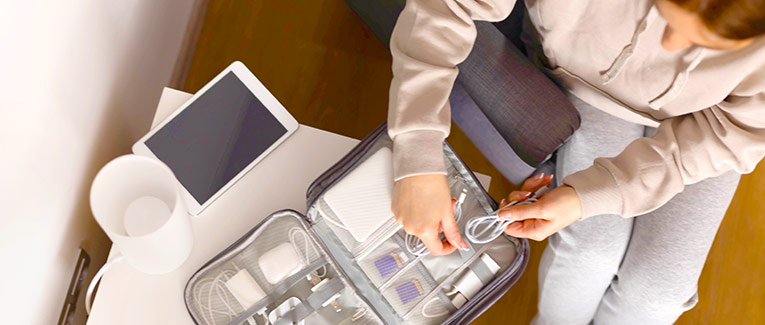
Everyone has experienced the frustration of having your phone die while nowhere near a charger. If you are somewhere unfamiliar, this can be a little scary, too.
But fret not, we’re here to help. We’ll answer the ‘how’, ‘what’, and ‘when’ of packing your electronics for travel.
Pack Only the Most Essential Devices
It is quite tempting to bring all of your devices along, but resist that temptation.
You know you don’t need that Kindle when you can just as easily read on your tablet.
Check the Power Outlet Type of Your Destination
There are a total of 15 types of outlet plugs used worldwide, and it will be in your best interest to figure out which one is commonly used wherever you’re visiting. This will determine whether you need to carry an adaptor or not.
- Type A and Type B, with two and three flat pins respectively, are most common in the USA, Canada, Mexico, and Japan.
- Type C, E, and F, with two rounded pins, are mostly used in Europe, and parts of Asia.
- In India, Type D is used, with 3 rounded pins.
- The Middle East, Singapore, the UK, and Ireland on the other hand, use Type G, which has three flat pins with thick rounded edges.
- The Type I that has 2 or 3 flat pins with thin rounded edges, is popular in Australia, as well as in China.
To be on the safest side, carry a multi-country universal plug adapter, or a USB power strip if you can spare the space in your luggage.
Decide On a Voltage Converter
More often than not, investing in a voltage converter proves to be futile, as most gadgets created nowadays function over a range of voltages and frequencies.
Their range easily covers 100-250 volts, which enables worldwide usage. Some gadgets can even malfunction if paired with voltage converters.
If for whatever reason, you do require a voltage converter, make sure to get the right one. A converter classified as a transformer for electronics is the most highly recommended.
The Art of Cord Packing
Consider one bag storage solutions for all your wires and cords.
Wrap your cables loosely, as anything too tight risks breakage. Use rubber twist ties to secure them, and avoid knots.
While cable protectors will be your best friends, wireless gadgets are going to be your saviors. These will make life easier not just while you’re on the go, but in general, too.
Test Your Setup
Check that your adaptors are compatible with all of the USB cables of your various chargers. If possible, carry just one super adaptor with a multi-plug setup. This way, you won’t need to carry too many power bricks.
Also, check if all of the electronics that you are carrying are running smoothly. Do make sure to get screen guards and protectors for your devices before you travel. This will help you avoid cracking your screen if something happens.
Alternate Gadget Chargers
1. Power Banks
A power bank is as much a suitcase essential as your standard charger. When selecting a power bank, look for portable designs, high charging input and output, and high charging capacity.
2. Smart Suitcases
Upgrading the smarts on your carryon is a decision you won’t regret. Smart suitcases now come with a multitude of features, including removable internal batteries and multiple USB charging ports to keep your gadgets charged while on the go.
3. Charging Wristlet
On the days when you have to head out for sightseeing, but forgot to charge your phone, you will be very grateful for this portable charging watch.
4. PhoneSoap Go
PhoneSoap Go, very true to its name, sanitizes your smartphone while you’re on the go.
It uses UV-C technology to sanitize your phone, and a built-in charger also serves the dual purpose of portable charging.
5. Charger Bracelet
Easily available on Amazon, this is your previously bland-looking USB cable fashioned into a chic and useful bracelet.
With these useful gadgets, you will always be fully charged abroad. Plus, with your travel insurance in place, you can worry less about losing your devices if there’s an issue with your luggage.

